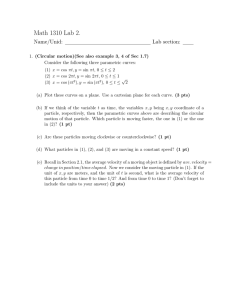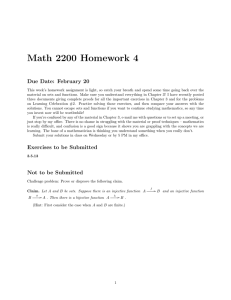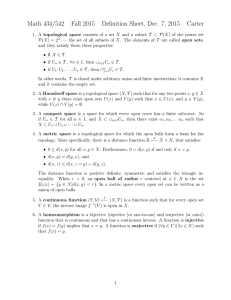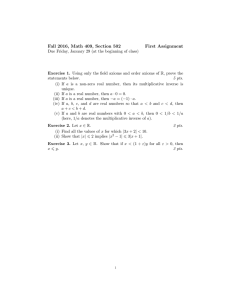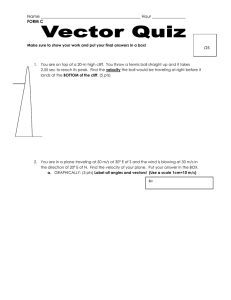Math 1310 Lab 2 Name/Unid:
advertisement
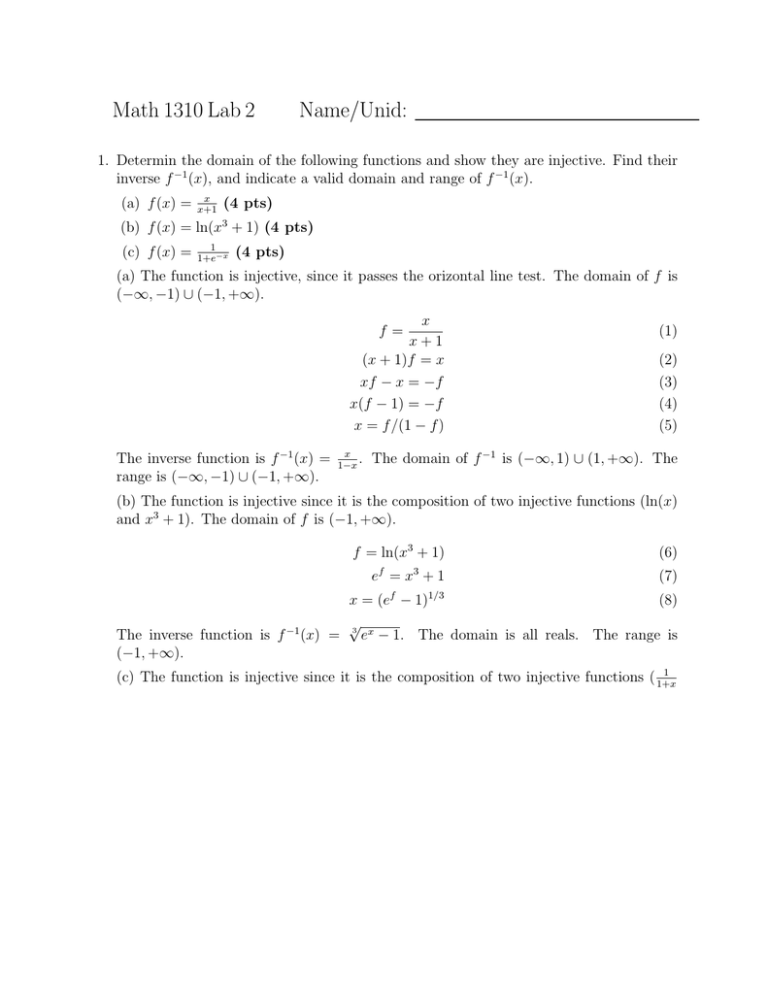
Math 1310 Lab 2 Name/Unid: 1. Determin the domain of the following functions and show they are injective. Find their inverse f −1 (x), and indicate a valid domain and range of f −1 (x). (a) f (x) = x x+1 (4 pts) (b) f (x) = ln(x3 + 1) (4 pts) (c) f (x) = 1 1+e−x (4 pts) (a) The function is injective, since it passes the orizontal line test. The domain of f is (−∞, −1) ∪ (−1, +∞). x x+1 (x + 1)f = x xf − x = −f x(f − 1) = −f x = f /(1 − f ) f= The inverse function is f −1 (x) = range is (−∞, −1) ∪ (−1, +∞). x . 1−x (1) (2) (3) (4) (5) The domain of f −1 is (−∞, 1) ∪ (1, +∞). The (b) The function is injective since it is the composition of two injective functions (ln(x) and x3 + 1). The domain of f is (−1, +∞). f = ln(x3 + 1) f The inverse function is f −1 (x) = (−1, +∞). 3 (6) e =x +1 (7) x = (ef − 1)1/3 (8) √ 3 ex − 1. The domain is all reals. The range is 1 (c) The function is injective since it is the composition of two injective functions ( 1+x and e−x ). The domain of f is all reals. 1 1 + e−x −x (1 + e )f = 1 f + e−x f = 1 e−x f = 1 − f 1−f e−x = f f ex = 1−f f x = ln 1−f x The inverse function is f −1 (x) = ln 1−x . The domain of f −1 is (0, 1). The range reals. f= Page 2 (9) (10) (11) (12) (13) (14) (15) is all 2. Parametric functions: plot the parametric curve (x(t), y(t)) and use arrows to describe the direction of the movement as t increases x(t) = t2 + t y(t) = t2 − t −2≤t≤2 (5 pts) 6 5 4 3 2 1 0 −1 −1 0 1 2 Page 3 3 4 5 6 3. The horizontal motion of a pendulum in centimeters is indicated by the function x(t) = 10 sin(2πt), where t is in seconds. Find the average velocity over the following time intervals (a) [1/4, 3/8] (1 pt) (b) [1/4, 5/16] (1 pt) (c) [1/4, 9/32] (1 pt) (d) [1/4, 17/64] (1 pt) (e) [1/4, 33/128] (1 pt) (f) [1/4, 65/256] (1 pt) Based on your results, estimate the instantaneous velocity at t = 1/4 (2 pts). Hint: if you are not sure, try choosing a very narrow interval [1/4, 1/4 + ], where is very small. (a)-(f) The formula one should use is the one of the difference quotient. If we denote by v̄ the average velocity we are interested in, we have v̄ = x(t2 ) − x(t1 ) , t2 − t1 (16) where t1 is the initial time and t2 is the final time. In the exercise t1 = 14 for all points 5 9 17 33 65 , 32 , 64 , 128 , 256 ). The function x(t) is x(t) = 10 sin(2πt). The (a)-(f), while t2 varies ( 38 , 16 values of the average velocity are -23.4315, -12.1793, -6.1487, -3.0818, -1.5418, -0.7710. The instantaneous velocity is zero. The approximations approach that slowly. Page 4
